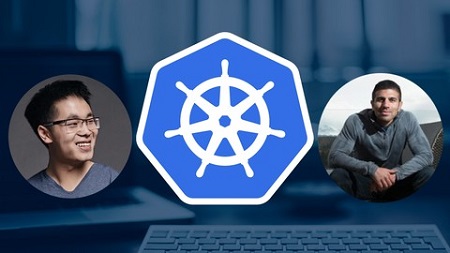
English | MP4 | AVC 1280×720 | AAC 44KHz 2ch | 8 Hours | 2.84 GB
Kubernetes from the ground up, deploy and scale performant, and reliable containerized applications with Kubernetes
Kubernetes is at the cutting-edge of how the greatest apps scale, the most successful businesses ensure reliability day-in-and-day-out through all kinds of conditions, and how DevOps engineers around the world keep calm and stay effective.
After being released as open-source from Google, where Kubernetes remained their “secret-sauce” in their seemingly infinite ability to scale their global-scale products & services without a hitch for almost a decade, Kubernetes + Docker has become the dominant and de-facto standard in how applications applications containerized using technologies such as Docker are architected, deployed, managed, and scaled.
If you consider Docker containers in an application the individual members of an orchestra, each with a specific job and responsibility to stay on-tempo and on-track with the rest of their peers to deliver a great performance, you can think of Kubernetes as the conductor of the orchestra. It’s no wonder then that with its deep history and long track record managing production applications for small startups to the biggest companies in the world Kubernetes is the de facto standard in the emerging area of Container Orchestration.
In this course, you’ll use Kubernetes to deploy real-world applications, and by doing so you’ll learn the concepts necessary to not just have a rote memorization of the individual tasks needed to operate Kubernetes, but a fundamental understanding of how you can use Kubernetes to build and deploy robust applications.
From our first simple deployment of a Tomcat container on a local cluster to building a High-Availability Cluster serving up WordPress on MySQL that can withstand failures of machines, networks, or disks we’ll walk through each task and show you not just the how, but help you understand the why – and go over practical “gotchas” and other pieces of advice that just reading the documentation won’t provide.
Whether you’re a beginning system administrator, an advanced developer, or even a CTO, when you Learn Kubernetes from a DevOps guru you’re bound to gain an understanding into the technology that underpins the most well-designed and delivered applications available today.
(This Kubernetes course contains a mini crash course on Docker, so even if you have zero knowledge about Docker, you can still follow along!)
Why DevOps skills?
Nowadays DevOps engineers are in great demand in the IT industry. Companies are looking for developers who can both develop and deploy the applications.
The average salary of a DevOps engineer is about $140,000 per year in Silicon Valley area which is 20% higher than the salary of a software engineer.
Master DevOps Skills means you will be staying ahead in the competitive job market!
What will you learn from this lecture:
In particularly, you will learn:
- Deploy production-grade applications on Kubernetes
- Be able to administer, understand, and deploy Kubernetes
- Deploy Highly Available Kubernetes clusters on AWS
- Make applications running on Kubernetes reliably available to users using Load Balancing
- Best practices of working with Kubernetes and Docker in the field.
- Invaluable DevOps skills.
Table of Contents
Introduction to this Course
1 Course Overview
2 How to Take this Course and How to Get Support
3 Text Lecture How to Take this Course and How to Get Support
Docker Crash Course
4 Introduction to Docker Crash course
5 Introduction to Virtualization Technologies
6 Docker Softwares Client-Server Architecture
7 Install Docker for MacWindows
8 Install Docker Toolbox
9 Run Our First Hello World Docker Container
10 Important Concepts of Docker Technology
11 Deep Dive into Docker Containers
12 Docker Port Mapping and Docker Logs Command
13 Docker Image Layers
14 Build Docker Images by Writing Dockerfile
15 Build Docker Images by using Docker Commit Command
16 Dockerfile In-depth
17 Push Docker Images to Docker Hub
18 Containerize a Simple Hello World Web Application
19 Text Direction Containerize a Hello World Web Application
20 Implement a Simple Key-value Lookup Service
21 Create Docker Container Links
22 Automate Current Workflow with Docker Compose
23 Deep Dive into Docker Compose Workflow
24 Time to get Started with Kubernetes
Getting Started with Kubernetes
25 Introduction to Container Orchestration
26 Overview of Kubernetes
27 NOTE AWS EKS is now generally available
28 Deploying Kubernetes
29 Minikube Setup
30 Text Lecture Minikube Setup
31 Your First Kubernetes Application
32 Your First Kubernetes Application Commands
33 Basic Kubectl
34 Basic Kubectl Commands
Kubernetes Basic and Core Concepts
35 Kubernetes Architecture
36 Scaling Kubernetes
37 Scaling Commands
38 Deploying to Kubernetes
39 Deployments Commands
40 Labels Selectors
41 Health Checking
42 Web Interface
43 Web Interface Commands
44 Exercise Kubernetes Basic Core Components
Deep Dive into Kubernetes
45 DNS Service Discovery
46 Text Lecture DNS Service Discovery
47 Volumes
48 Volumes Commands
49 Note Secrets
50 Secrets
51 Secrets Commands
52 Usage Resource Monitoring
53 Usage Resource Monitoring Commands
54 Namespaces Resource Quotas
55 Namespaces Resource Quotas Commands
56 Auto-Scaling
57 Auto-Scaling Commands
58 Auditing
59 Text Lecture Auditing
60 Exercise Auto-Scaling Resources
61 Bonus Lectures Kubernetes Networking
Kubernetes in Production
62 High Availability
63 Masters
64 Text Lecture Masters
65 Setting up High Availability
66 Volumes on AWS
Helm
67 Introduction
68 Section Overview
69 What is Helm
70 Helm Installation Guides
71 Helm First Deployments
72 Helm Chart Creation
73 Helm Template Calls
74 Helm Values
75 Helm Commands
Wrapping Up
76 Finishing Up
77 Text Lecture Future Learning
78 Coupons to Our Other Courses
Resolve the captcha to access the links!